Perspective is a fundamental concept in visual arts that helps artists create the illusion of depth and space on a two-dimensional surface.
It is a graphic resource that uses converging lines and other techniques to make objects appear closer or farther away, creating a sense of depth and dimensionality.
This article will explore the concept of perspective and its use in visual arts. Enjoy your reading!
What is perspective?
Perspective is a graphic resource that artists use to create the illusion of three-dimensionality on a flat surface, such as paper or canvas.
By using the effect of converging lines, artists can make objects appear to be closer or farther away, creating a sense of depth and space.
Artists have been using this technique for centuries, from Renaissance masters to contemporary artists.
The visual effect of converging lines
To understand the influence of converging lines on graphic representation in perspective, observe the illustrative example of the cube below:
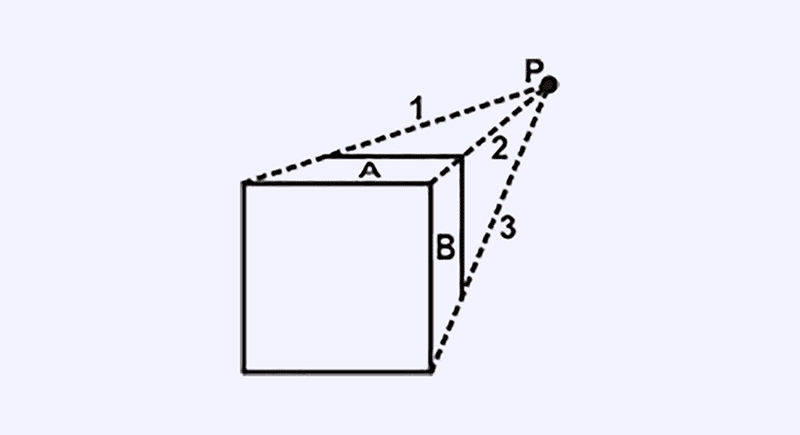
Converging dotted lines 1, 2, and 3 at point P creates the illusion of volume by outlining the edges of faces A and B.
As the lines move away from the foreground, they taper and converge towards a single point, giving the impression of depth and space.
This effect is specific to perspective drawing, and it allows artists to create lifelike and realistic representations of objects and scenes.
In the example of the cube, this effect can be observed as the edges of the cube appear to recede into the distance. This creates the illusion of a three-dimensional object on a two-dimensional surface.
Perspective in Environments
The same graphic scheme with converging lines moving towards a point can be applied to any type of drawing, including environments.
In the example of the environment below, these lines create the illusion of space between the foreground and background, giving a sense of depth to the drawing.
The converging lines create a vanishing point, towards which all lines appear to converge. This makes objects appear smaller as they recede into the distance.
As you can see, this effect is essential for creating realistic and lifelike art representations of environments and landscapes.
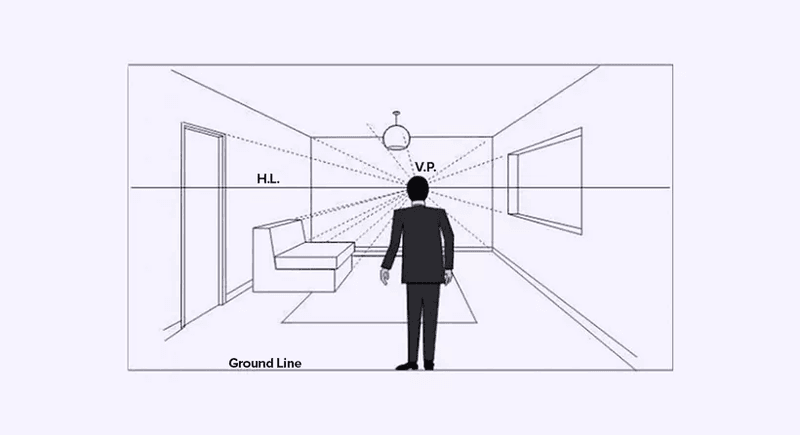
These lines belong to a set of graphic resources classified as elements of perspective.
These elements are essential in the schematic construction of forms and space, as they imitate the visual perception of the human eye.
Furthermore, by using these techniques, artists can create convincing illusions of depth and space on a two-dimensional surface.
Perspective elements
Now, let's learn about the elements that make up perspective. We will explore the techniques and principles that artists use to create convincing illusions of depth and space.
There are four elements of perspective that determine the level and visual angle of the viewer in the context of the drawing:
- Horizon Line;
- Point of View;
- Vanishing Point;
- Convergence Lines.
For a basic study of perspective, it is essential to know these elements and understand their correct application.
Horizon Line
The Horizon Line is the element of perspective construction that represents the viewer's eye level.
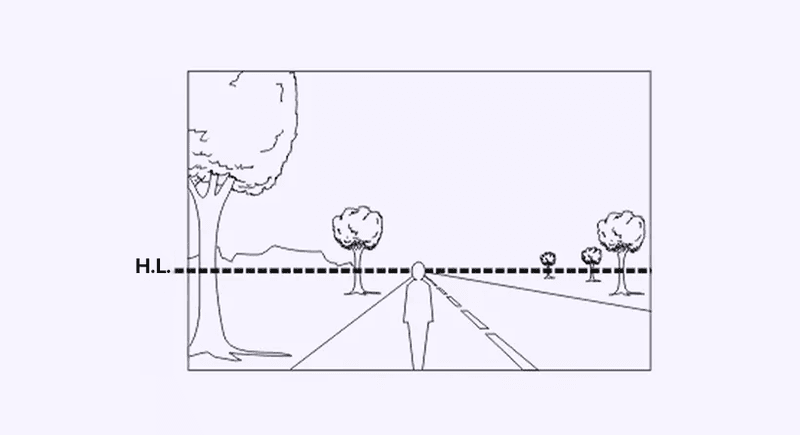
In a landscape, the horizon line is the line that separates the sky and the land. This way, when seen from a distance, it can be located at the base of mountains and runs horizontally across the sea level.
Point of View
The point of view (POV) is often identified in the graphic representation of perspective by a vertical line perpendicular to the horizon line. The point of view is precisely located at the intersection of these two lines.

Depending on the visual angle of observation of the subject, the vertical line that locates the point of view can be centered in the composition or on one of its sides, left or right.
Vanishing Point
The vanishing point (VP) is the point on the horizon line to which all parallel lines converge when viewed in perspective.

Certain types of perspectives may call for the use of two or more vanishing points. As a result, the vanishing points may be positioned on both the horizon line and the vertical line of the viewpoint.
Furthermore, it is also possible for the vanishing point to fall outside of both the horizon line and the viewpoint.
Vanishing Lines
The lines that represent the edges of objects are called Vanishing Lines.
They are part of a set of graphical features classified as elements of perspective, essential in the schematic construction of shapes and space, imitating the visual perception of the human eye.
Narrowing these lines towards the vanishing point generates the visual sensation of depth in the foreshortened faces of objects in perspective.

Therefore, when drawing objects in environments or landscapes, it's important to use perspective elements to ensure the structure isn't distorted. Combining these elements allows us to create graphic schemes that accurately represent the scene we want to draw.
In the next section, we'll explore the different types of perspective visualization to learn more about the basics of these graphic resources.
4 types of perspective
There are 4 types of perspective, depending on an object's position or visual level in relation to the observer.
These perspectives can be applied with one, two, or three vanishing points. The 4 types are:
- Parallel perspective: one-point perspective is also known as parallel perspective. It only requires one vanishing point located on the horizon line, and all lines parallel to each other in the real world remain parallel in the drawing.
- Oblique perspective: two-point perspective is the same as the oblique perspective. In this type of perspective, the object is placed obliquely to the viewer, and its lines of convergence move towards two vanishing points.
- Aerial perspective: three-point perspective is a type of perspective where three points of the object or scene converge towards three different vanishing points.
- Counterpoint perspective: known as a worm's-eye view. It refers to a perspective in which the viewer is positioned at a low angle, looking up toward the subject, creating a sense of dominance or powerlessness.
Parallel perspective (1PP)
The vanishing lines converge to a single point (VP) in parallel perspective drawing.
Therefore, objects in this situation have their front faces parallel to the observer, whether they are located in front of them, to the left, or to the right.
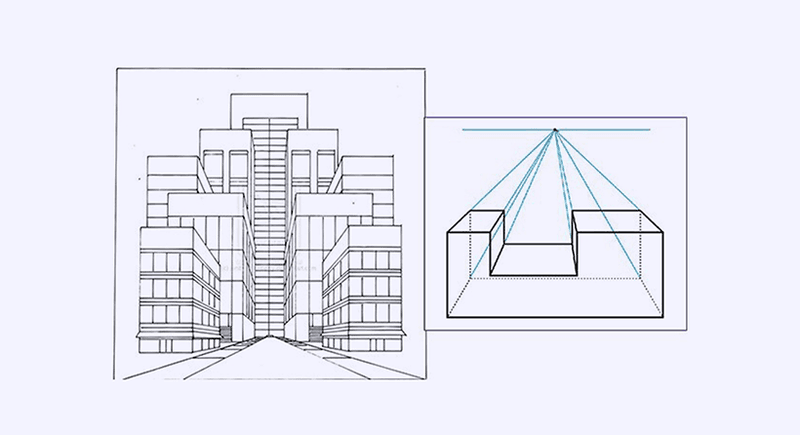
One detail to be observed is that in parallel perspective, the viewpoint (VP, vertical dashed line) is located perpendicular to the horizon line, so close to the vanishing point that it appears to be on it (VP).
Oblique perspective (2PP)
When an object is in an oblique position, with one of its edges facing the viewer, its lines of convergence move towards two points (VP1 and VP2).
As shown in the illustration of the cube below, none of the object's lines are represented in a horizontal position.
Instead, they converge towards one of the vanishing points (VPs) depending on their orientation.
For example, if a line is neither vertical nor horizontal, it will converge towards the VP that matches its direction.

Regarding the point of view (PV), its representation on the horizon line is centered between the two vanishing points (PF1 and PF2).
These, in turn, should be as far apart as possible to avoid errors in the drawing.
Aerial perspective (3PP)
We use this perspective when we want to represent an object from a high vantage point, such as an airplane or a tall building.
This technique requires the use of three vanishing points: two on the horizon line and one on the vertical axis of the viewpoint.
In aerial perspective, the converging lines of an object's structure are rarely horizontal or vertical, as they all converge towards one of the three vanishing points.
This creates the illusion of depth and three-dimensionality and helps to portray the object from a bird's eye view accurately.
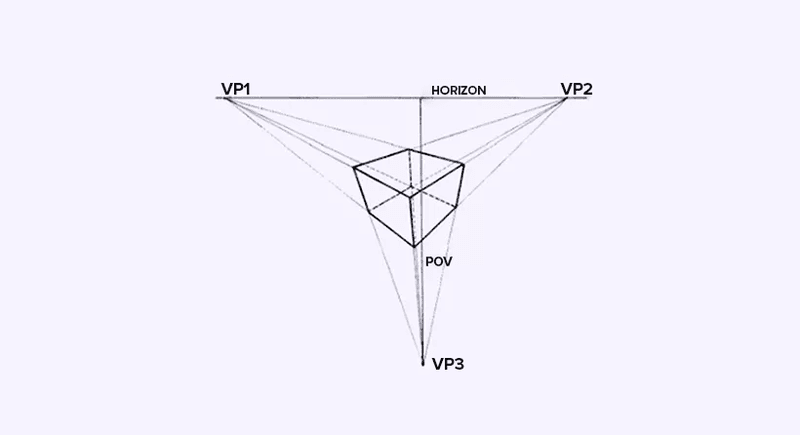
Regarding the viewpoint (PV), it follows the same criteria as the oblique perspective. It remains represented at a central point between the vanishing points VP1 and VP2 on the horizon line (HL).
Counter shot perspective (3PP)
The worm's eye view perspective is similar to the aerial perspective, using three vanishing points.
The difference is that the observer is positioned very low, which makes the perspective look the opposite of the aerial perspective.
Because of this, the third vanishing point (PF3) is located above the horizon line. Check out the illustration for an example.

We just finished a basic study on perspective. However, there's still so much more to learn about this topic. Our goal here was to provide you with some technical knowledge that we believe can be extremely useful when creating images in Photoshop.
By having a good understanding of perspective, you'll not only be able to create better compositions, but also to choose the right images and assets to work with.
We hope you found this information helpful and that you'll continue to explore and study more about perspective.
As a friendly suggestion, we highly recommend the book Perspective Made Easy by Ernest Norling. It's a great source of information and can help you take your skills to the next level!









